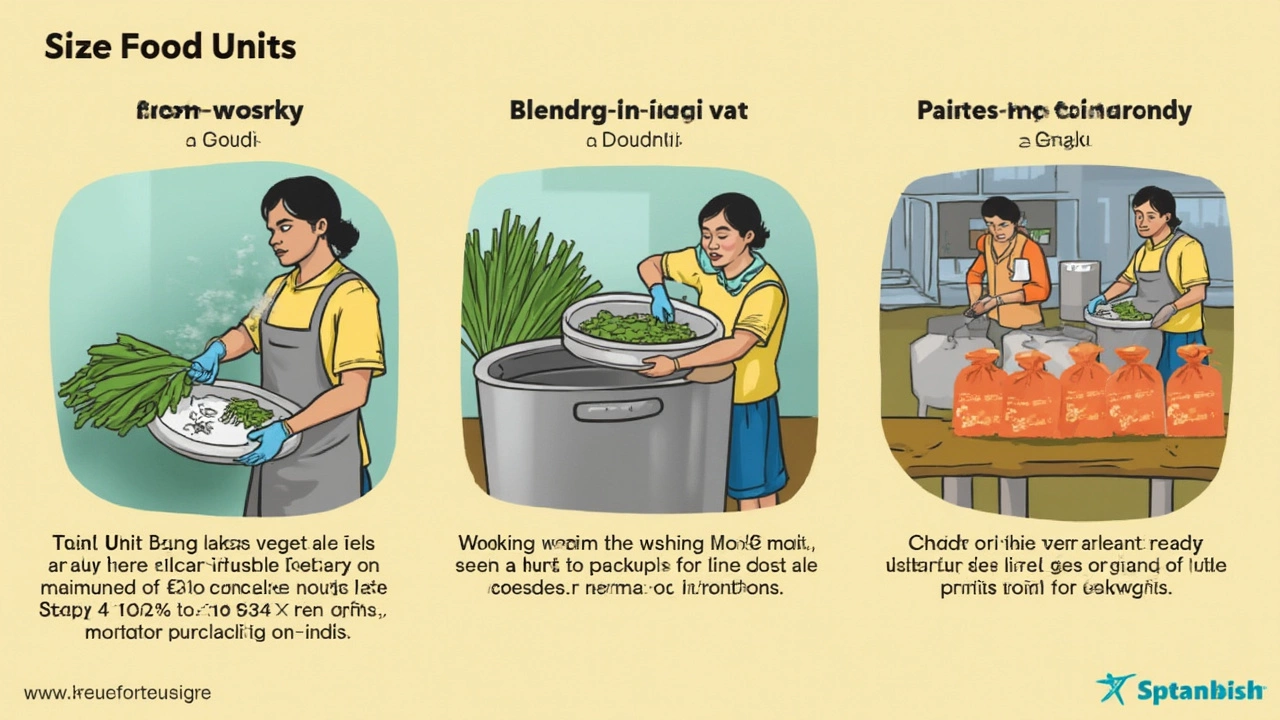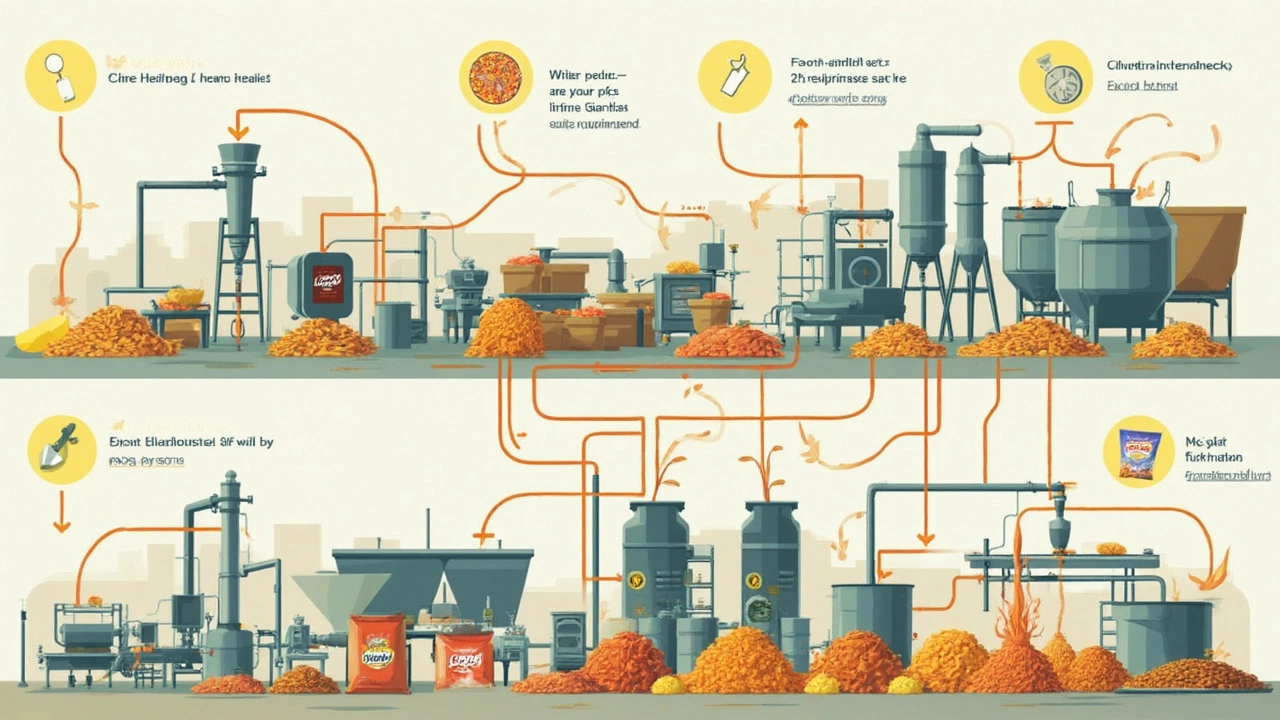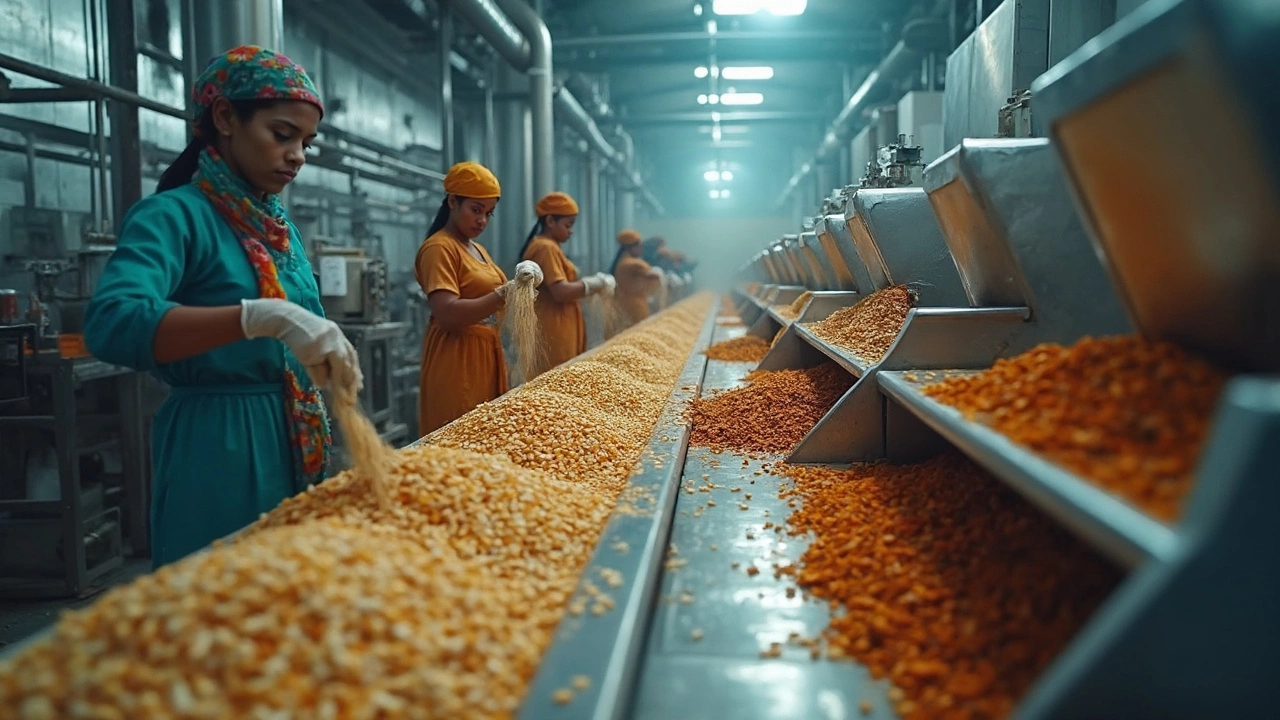Ever wondered how your favorite snack goes from one bland, raw thing into something totally delicious and shelf-stable? It all comes down to a bunch of steps called unit operations. Every food factory, from the place making ketchup bottles to massive snack plants, relies on these steps to turn raw ingredients into the food you know.
Unit operations aren’t some fancy science buzzword. They’re just the basic building blocks—the chopping, mixing, heating, cooling, and even packaging—that get repeated in almost every food plant. Each one has its job: maybe separating solids from liquids, or making sure dough gets just the right texture. If you’ve ever chopped veggies or boiled pasta at home, you’ve already done a few yourself—just on a much smaller scale.
The way these steps are organized isn’t random. There’s a pretty clear system to how the food industry classifies unit operations, and it helps companies figure out exactly where they can boost efficiency, save money, or keep food safer. Knowing the basics can make a big difference, whether you’re running a bakery or just want to geek out over how your favorite cereal is made.
- What Are Unit Operations?
- Physical Unit Operations Explained
- Chemical and Biological Transformations
- Mechanical and Thermal Processes
- Key Tips for Efficient Food Processing
What Are Unit Operations?
When you peel back the layers of any unit operations problem in the food industry, you’ll quickly see it’s just a series of common, repeatable steps. These steps are designed to transform raw ingredients into a finished product, step by step. There’s nothing mysterious. It’s how bread starts with flour and water, then goes through mixing, kneading, and baking until you smell it fresh out of the oven.
Unit operations basically break down the big job of food processing into small chunks. Think chopping, sieving, drying, fermenting, or packaging. Each chunk has a clear goal: maybe making food safe to eat, keeping it from spoiling, or shaping it into a form people want. By chunking the work this way, factories can repeat steps non-stop without messing up the recipe.
Food engineers use this idea to plan everything. For example, milk-making plants always use a pasteurization step to zap bacteria before it gets bottled. Potato chip factories wash, slice, fry, and flavor potatoes, with each stage a different unit operation.
- Unit operations repeat across all sorts of foods—cheese, cookies, juices, spices—you name it.
- Big factories often double up or adapt certain steps to match their equipment or the type of food they’re making.
- These steps are easy to scale—if it works at home, it’s just a matter of figuring out how to do it for a million packages a day.
So, when you think about food production, don’t picture a chef handcrafting every batch. Picture a series of smartly organized steps, each with a clear purpose, working together to keep the food safe, tasty, and ready for your next snack attack.
Physical Unit Operations Explained
Physical unit operations are the bread and butter of food processing. They basically involve changing the shape, size, or location of food ingredients without messing with their actual chemical structure. Think of things like cutting, sorting, mixing, and separating. These moves might sound basic, but they control everything from product consistency to food safety.
Let's break down some of the most common physical unit operations you’ll see in any food factory:
- Size Reduction: Stuff like grinding wheat into flour or chopping vegetables for frozen mixes. It’s all about getting pieces to the right size for the next step.
- Mixing: Makes sure things like cake batter or salad dressing taste the same every time. Good mixing means every bite delivers the expected flavor.
- Separation: Removing what you don’t want, like pits from cherries or shells from nuts. It also includes filtering juice or clarifying wine.
- Screening and Sieving: Sorts ingredients by size. This stops anything too big or too small from moving down the line and messing up your final product.
- Transportation: Conveyor belts and pumps move stuff from one stage to the next, keeping lines humming and reducing the need for people to lug things around.
Food processing lines can run thousands of kilos per hour. Check out this quick table—these numbers show how much food can pass through some common physical unit operations per hour:
| Operation | Example Food | Capacity (kg/hour) |
|---|---|---|
| Grinding | Wheat | Up to 10,000 |
| Chopping | Carrots | 2,000-5,000 |
| Mixing | Batter | 3,000-7,000 |
| Screening | Sugar | Up to 8,000 |
One pro tip: the smoother these steps run, the fewer problems you’ll have down the line. Even something simple like making sure the grinder is the right size can save hours fixing clogs later. Companies spend big on regular checks and maintenance so production doesn’t come to a halt when orders are flying in.

Chemical and Biological Transformations
This is where food really changes. In the food industry, unit operations like fermentation, enzymatic treatment, and chemical reactions push ingredients past their original form. You'll see these steps everywhere—from making yogurt at home to mass-producing bread or beer. They're not just about taste, either; they’re usually about safety, shelf life, and nutrition.
Unit operations involving chemical or biological changes often rely on specific conditions like temperature, time, or the type of microorganism used. For example, fermentation in dairy products uses special bacteria to turn milk into yogurt, boosting gut-friendly bacteria and tangy flavors. Bread gets fluffy thanks to yeast turning sugars into carbon dioxide and ethanol. Even simple things like adding citric acid to canned veggies count because they stop bacteria from growing, making the food safe for long-term storage.
- Fermentation: Used for yogurt, cheese, pickles, sauerkraut, soy sauce, and many more. It improves shelf-life and can boost nutritional value.
- Enzymatic Browning: Ever notice apples turning brown after being sliced? That’s an enzymatic process. Food factories sometimes use lemons or ascorbic acid to slow it down.
- Chemical Preservation: Sulfites in dried fruits or nitrites in cured meats are common for locking in color and stopping spoilage.
- Hydrolysis: Used in making corn syrup where enzymes break down starches into sugars to sweeten things up.
The food industry tracks chemical and biological transformations pretty closely with careful lab equipment and sensors. A small mistake can ruin whole batches or, worse, make food unsafe. That’s one reason factories have strict rules on how long to ferment, how warm the tank should be, or which starter bugs they use. The tiniest change in pH or temperature can totally throw off a recipe.
| Operation | Product Example | Main Benefit |
|---|---|---|
| Fermentation | Yogurt | Improved texture, gut health, shelf life |
| Enzymatic Hydrolysis | High fructose corn syrup | Sweeter taste from starch |
| Chemical Preservation | Dried apricots | Longer shelf life, color retention |
| Protein Denaturation | Cheese-making | Curd formation and unique textures |
When you think about chemical and biological unit operations, you’re looking at the heart of food transformation. Everything from sourdough bread to kombucha depends on nailing these steps. Even a slight tweak in process can give you something totally new—sometimes it’s a tasty discovery, and sometimes it’s a mess.
Mechanical and Thermal Processes
No way around it—good food processing means you need to get hands-on (or, well, machine-hands-on) with some mechanical and thermal work. These unit operations are everywhere in the food industry. Let’s break down what happens and why it matters.
Mechanical processes are all about changing the shape, size, or uniformity of food. Think cutting, grinding, mixing, or even pumping stuff through pipes. For example, making ground meat uses huge grinders to tear down big pieces into tiny ones, giving you those neat burger patties or sausages. Slicing is pretty common too—if you’ve ever seen how potato chips start as a pile of real potatoes, it all starts at the slicer.
- Mixing: Combining ingredients for consistency, like in bread dough or cake batter. Machines in factories mix way faster and more evenly than we do at home.
- Emulsifying: Think of mayo—oil and water don’t mix by themselves, but heavy-duty machines make this happen so it won’t separate in your sandwich.
- Pumping: Moving liquids (like tomato sauce) from one place to another without letting in germs or air that could ruin things.
Then you’ve got thermal processes—using heat or cold to change the food. This isn’t just about making things tasty; a lot of it is about killing bacteria or giving food a longer shelf life. Pasteurizing milk is a classic: just enough heat zaps germs, but doesn’t change the taste. Another example is blanching veggies before freezing. The quick heat stops enzymes, so the veggies don’t turn mushy or brown later on.
- Heating: Baking bread, roasting coffee beans, or cooking canned beans all need controlled heat to get the taste and safety right.
- Cooling and Freezing: Companies snap-freeze peas right after picking to lock in flavor and vitamins. Quick freezing makes a real difference compared to slow freezing at home.
- Evaporation: This is key for things like condensed milk—removing water by boiling it off saves space and makes stuff last longer.
If you want food that’s safe, tasty, and looks good, these mechanical and thermal unit operations have to be dialed in just right. The whole food industry—from massive factories to your favorite local bakery—relies on these processes every day. They might not sound glamorous, but nothing gets done without them in the world of food processing.

Key Tips for Efficient Food Processing
Getting the most out of each unit operation isn’t just about buying cool new equipment. Efficiency in the food industry is about doing more with less—less time, less energy, and less waste. Here’s what actually works, based on real factory practices and hard numbers.
- Keep equipment clean and calibrated. Even a tiny build-up inside a filler or mixer can throw off measurements, slow down lines, or cause product recalls. Most food plants schedule cleanings daily or between shifts for sensitive products like dairy or ready meals.
- Streamline your workflow. Arranging machines and workstations in the right order cuts walking time and the risk of ingredient mix-ups. Lean Manufacturing isn’t just a buzzword—factories using it have seen up to 30% faster turnaround on common lines.
- Monitor process temperatures closely. Pasteurization, baking, and cooling steps are all about hitting the sweet spot. Too low, and germs survive. Too high, and food dries out or burns. Temperature sensors pay for themselves fast by cutting mistakes.
- Don’t ignore downtime data. Every minute a conveyor or fryer is down costs money. Smart tracking systems can spot patterns. One plant in Wisconsin cut breakdowns in half by simply reviewing daily logs and scheduling fixes during lulls.
- Reduce waste at every step. Trimmings and overflows add up huge. For example, cutting water use in vegetable cleaning by just 10% can save a mid-size processor thousands of gallons every week—easy win for the budget and the planet.
If you want a quick look at where food plants lose time and money during processing, check out this table:
| Area of Loss | Average Percentage Loss | Common Cause |
|---|---|---|
| Raw Material Waste | 8-10% | Trimming, over-processing |
| Downtime | 5-15% | Breakdowns, cleaning, changeovers |
| Energy Usage | 12-20% | Poor insulation, outdated tech |
| Labor Inefficiency | 7-9% | Poor training, non-optimized layout |
Notice how most losses aren’t just about machines—they’re about routines. Even the best tech can’t fix a workflow that’s out of order or a habit of skipping maintenance. Stick to these basics and you’ll get far better results than just throwing money at the latest gadget.
